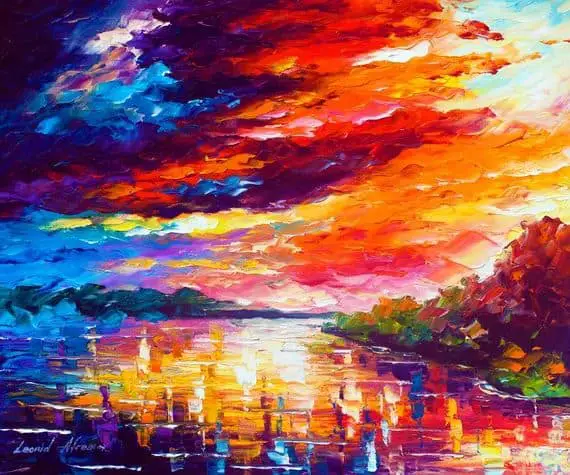Art that utilizes bright, vivid colors has many different names depending on the specific style, medium, and era. Some common terms for brightly colored art include Fauvism, Expressionism, Pop Art, Neon Art, and Psychedelic Art.
Definitions and Key Characteristics
Fauvism was an early 20th century modern art movement characterized by the use of bold, lively colors applied in an aggressive, direct manner. The Fauves were a loose group of French painters active in the early 1900s who emphasized painterly qualities over natural colors and traditional forms. Their art was known for its wild brushwork and intense, often unrealistic colors. Key artists included Henri Matisse, André Derain, and Maurice de Vlaminck.
Expressionism emerged in Germany in the early 20th century as a reaction against Impressionism and realism. Expressionist artists sought to convey emotion and meaning over naturalistic representation. Their art featured vivid, often non-naturalistic colors and distorted forms and perspectives. Expressionism influenced many later modern art movements and had a major impact across various media including painting, printmaking, drawing, photography, film, theater, dance, architecture, and literature. Key Expressionist artists include Wassily Kandinsky, Ernst Ludwig Kirchner, Emil Nolde, and Edvard Munch.
Pop Art and Neon Art
Pop Art arose in the 1950s and 1960s, largely in the United States and Britain. It drew inspiration from popular culture and consumer goods, often depicting mundane or kitschy objects in an ironic or humorous way. Pop Art frequently made use of bright, intense, artificial colors. Prominent Pop Artists like Andy Warhol, Roy Lichtenstein, and James Rosenquist created boldly colored screenprints, paintings, and sculptures of consumer products, celebrities, comics, advertisements, and more.
Related to Pop Art, Neon Art also emerged in the 1960s and made use of bright neon glowing lights to create vibrant, eye-catching works. Pioneering Neon Artists like Stephen Antonakos, Bruce Nauman, and Keith Sonnier bent and shaped neon tubing into colorful sculptural pieces and installations.
Psychedelic Art
Psychedelic art is characterized by bright, surreal imagery intended to evoke mind-altering hallucinogenic experiences. It originated in the mid-1960s counterculture and became associated with rock music posters, album covers, light shows, movies, and more. Psychedelic visual styles aim to recreate the sensory experience of psychedelic drugs, featuring swirling, pulsating shapes and colors. Key psychedelic artists include Wes Wilson, Victor Moscoso, Bonnie MacLean, Mati Klarwein, and Peter Max.
Other Vibrant Art Genres and Styles
In addition to the major movements discussed above, many other art genres and individual artists make use of bright, bold colors, including:
– Folk art featuring vivid colors like Haitian art or Mexican Retablos paintings
– Graffiti art and street art using spray paint and markers
– Color field painting like works by Mark Rothko, Barnett Newman, and Helen Frankenthaler
– Op art, kinetic art, and optical illusion art that plays with intense colors
– Digital art by contemporary artists that employs neon bright palettes
– Individual artists like Kehinde Wiley who paint realistically in vibrant hues
Reasons for Using Bold Colors
There are many reasons why artists choose to work with bright, expressive palettes:
– To portray a particular emotion or feeling more vividly
– To create an eye-catching, energetic composition
– To replicate visual phenomena like light or dreams
– For symbolic purposes, where colors represent concepts
– To highlight contemporary commercial products and pop culture
– For decorative appeal and visual interest
– To experiment with color intensity and interaction
– For cultural expression, folk art traditions, or personal heritage
– To stimulate viewers’ senses and evoke visual exhilaration
Conclusion
Art with bold, lively colors has been created across cultures and time periods, but was particularly emphasized in modern art movements like Fauvism, Expressionism, Pop Art, Psychedelic Art, and Neon Art. Vibrant palettes allow artists to communicate emotion, address contemporary society, replicate visual experiences, decorate spaces, and highlight their unique cultural perspective and artistic vision. Bold color in art captures viewers’ attention and stimulates their senses, creating an energized, exhilarating viewing experience.
| Art Movement | Time Period | Key Artists | Characteristics |
|---|---|---|---|
| Fauvism | Early 1900s | Henri Matisse, André Derain, Maurice de Vlaminck | Wild brushwork, bold unrealistic colors |
| Expressionism | Early 20th century | Wassily Kandinsky, Ernst Ludwig Kirchner, Emil Nolde | Distorted perspectives, vivid non-naturalistic colors |
| Pop Art | 1950s-1960s | Andy Warhol, Roy Lichtenstein, James Rosenquist | Vibrant palettes, mundane consumer subject matter |
| Psychedelic Art | 1960s | Wes Wilson, Peter Max, Victor Moscoso | Surreal swirling shapes and patterns |


